|
Battle of the Bloody Angle, Spotsylvania Court House
Battle of the Mule Shoe Salient and Bloody Angle History
Battle of Spotsylvania Court House
The Battle of Spotsylvania Court House is a continuation of the Battle of the Wilderness. General Grant's decision to move forward to Spotsylvania changed the course of the war. For the first time in the Eastern Theatre, the Army
of the Potomac went forward after a battle and maintained control of the initiative for the rest of the war. If viewed as
one campaign, the Wilderness / Spotsylvania Campaign is the bloodiest in American history. The Battle of Spotsylvania, May
8-21, 1864, included some of the most desperate hand-to-hand fighting of the Civil War.
| Bloody Angle: Battle of Spotsylvania Court House |
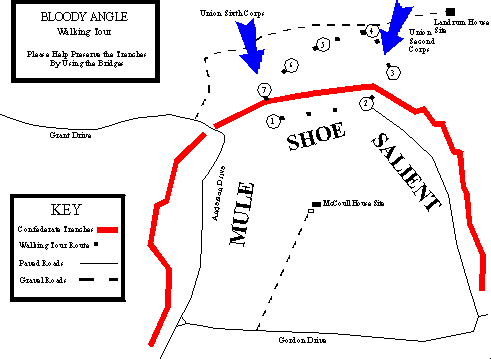
|
| Bloody Angle. National Park Service |
Bloody AngleThe following describes the Bloody Angle: Along
a 200 yard stretch of the Confederate line centered at what was called the West Angle of the Mule Shoe; soldiers struggled
for 20 hours in the longest hand-to-hand fight of the war. Harris' Brigade of Mississippians and McGowan's Brigade of South Carolinians battled portions of the Union VI Corps. On May 12, Union and Confederate soldiers struggled over this ground for more than 20 hours, through pouring rain,
producing unparalleled examples of both courage and carnage.
The Mule ShoeLate
on May 8, Confederate Edward Johnson's division, about 3.000 men, built an outer line of entrenchments.
"The ground was examined, and General Edward "Allegheny" Johnson
found we were on the brow of a ridge, which turned somewhat shortly to the right. The campfires in our front seemed to us
to be considerably below the plane of our position...It was now quite late in the night, and General Johnson deflected his
line and followed the ridge, so far as it could be distinguished in darkness." Lieutenant W.W. Old,
Johnson's aide
The "deflection" in the Southern line became known as the "Mule Shoe," or
simply the "Salient." Confederate officers recognized the vulnerability of the position but, with the added support of over
20 artillery pieces, they felt the line could be held. On May 10, a preliminary Union
assault, led by Colonel Emory Upton, met with limited success against the northwestern portion of the Salient. Upton's achievement
prompted Union commander Ulysses S. Grant to organize a much larger attack. He massed a column of 20,000 troops; their objective:
to carry the apex of the Salient.
Peering through the morning mist in the predawn darkness of May 12, the Confederates
caught their first glimpse of the Union attack.
"Click, click sounded along
our ranks as each man cocked his musket and every eye was strained to discover in the dim light of early dawn, the first appearance
of the Yankee line as it emerged from the woods. Some moments passed before we could see a single Yankee, when suddenly
the enemy poured out of the woods on our right; as far as the eye could see the enemy was seen, covering the whole field.
. . ." Isaac Seymour, Confederate Staff Officer
With an hurrah, the blue masses swept forward, first striking at the
"East Angle." They quickly captured General Johnson and over 2,500 of his men, thanks in part to the absence of Confederate
artillery which had been ordered away the previous evening.
"The storm had burst upon us. I could see General Johnson with his
cane striking at the enemy as they leaped over the works, and a sputtering fire swept up and down our line, many guns being
damp, I found myself. . . in the midst of foes, who were rushing around me, with confusion and a general melee in full blast."
Major Robert Hunter, Confederate Staff Officer
| Fighting at the Mule Shoe |
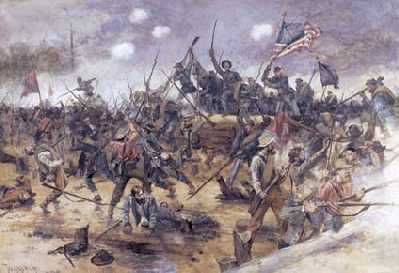
|
| Fighting at the Mule Shoe, Spotsylvania, Courthouse |
(Right) Artist conception of the fight at Bloody Angle during the Battle
of Spotsylvania Court House.
Second Corps AttacksGeneral
Winfield Scott Hancock's Second Corps attacked across the open ground.
"I remember the thin
picket line of the enemy, with their bewildered look. There was a little patter of bullets,
and I saw a few of our men on the ground; one discharge of artillery. . . and we were up on the works with our hands full
of guns, prisoners and colors." General Francis Barlow, USA
Union Troops Form The
Northern columns formed along the tree line, and Union soldiers built trenches running parallel to the dirt road after the
morning attack.
Although one of the largest frontal
assaults of the war, the attack began inauspiciously because commanding officers were not certain how to reach the Confederate
works. After much initial confusion, General Barlow, overcome by the "absurdity of the situation," exclaimed to his guide:
"For Heaven's sake, at least face us in the right direction, so we shall not march away from the enemy and have to
go around the world and come up in their rear!"
| Battle of Bloody Angle, Spotsylvania Court House |
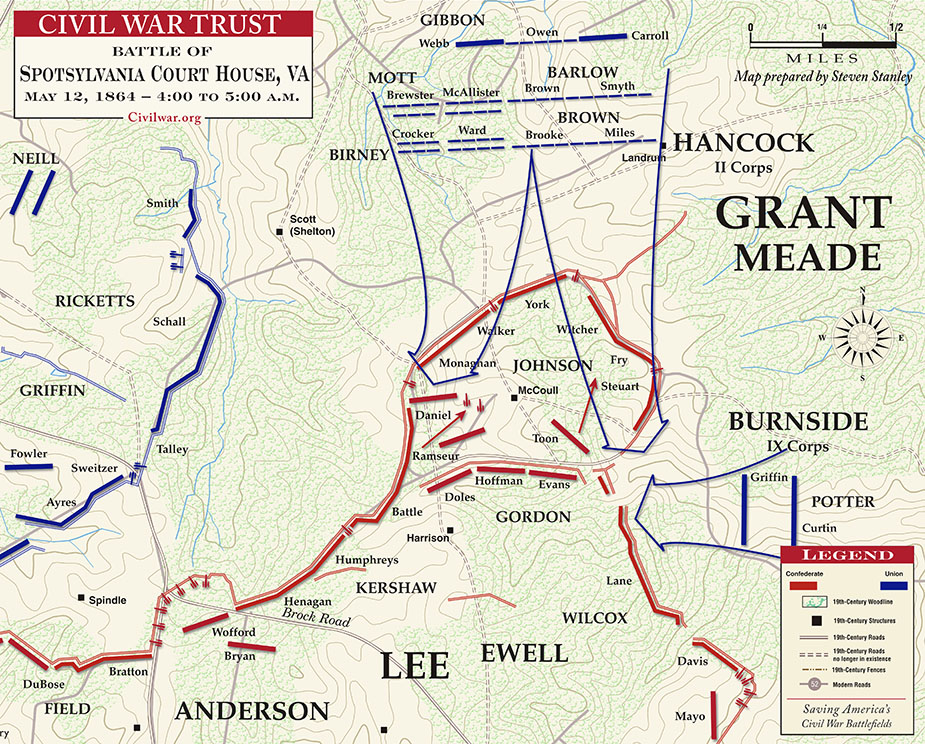
|
| Battle of Bloody Angle, Spotsylvania Court House Battlefield Map. Courtesy Civil War Trust. |
Frontal Assault
They received a tremendous
fire as they came up out of the ravine. . . No troops could stand such a fire and they were driven back, leaving the ground
strewn with their dead and wounded. Troops cannot live over that slope. Colonel
J.B. Parsons, 10th Massachusetts Infantry Regiment
Small Measures of Protection
During the savage fighting for the Bloody Angle, small ridges
and swales provided some measure of protection from the steady storm of lead. Those who still survived now faced hours of
harrowing combat at point blank range in a pouring rain.
The dead and wounded were torn to pieces by the canister as it swept
the ground where they had fallen. The mud was halfway to our knees. . . Our losses were frightful. What remained of many different
regiments that had come up to our support had concentrated at this point, and had planted their tattered colors upon a slight
rise of ground where they staid during the latter part of the day. Private G.N. Galloway, 95th Pennsylvania Infantry Regiment
| Civil War defenses near Bloody Angle |
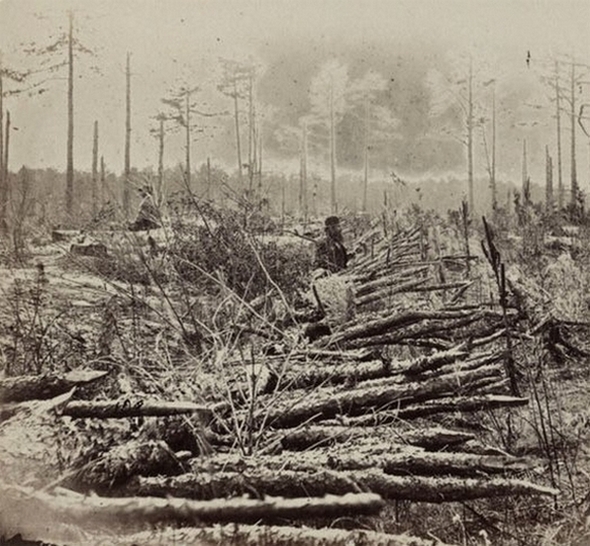
|
| Confederate entrenchments near the Bloody Angle with abatis. LOC. |
| Battle of the Salient Mule Shoe and Angle |
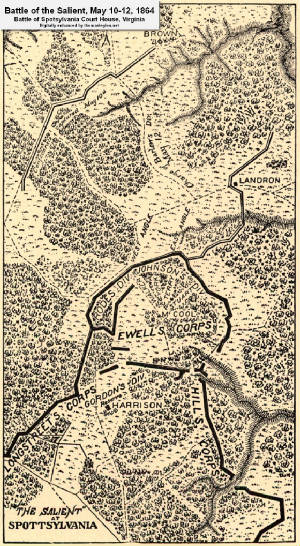
|
| Battle of the Salient at Spotsylvania Court House, VA |
(Left) The salient at Spotsylvania, May 10-12, 1864. Map indicates the positions
of the Corps of Longstreet, Ewell and Hill, and the charge of Barlow's Division on May 12. LOC. (Right) Civil War
era photo of Confederate trenches fortified with abatis near "The Angle" at Spotsylvania Court House. LOC.
The Bloody Angle
Throughout the afternoon and
well into the night, Yankee and Rebel fought each other with relentless determination.
Nearby, a 22-inch oak, was shattered by the incessant musket and artillery fire.
Nothing but the piled up
logs of breastworks separated the combatants. Our men would reach over the logs and fire into the faces of the enemy, would
stab over with their bayonets; many were shot and stabbed through crevices and holes between logs; men mounted the
works and with muskets rapidly handed them kept up a continuous fire until they were shot down, when others would take their
places. General Lewis Addison Grant, USA
The outnumbered Confederates eventually fell back to a new line, and
the battle of May 12 ended, but the fight for the Bloody Angle stood out in sharp contrast from other battles. Its terrible
slaughter seemed to signal a shift in each side's perception of this great American Civil War. Never again would Lee have
the strength to lead his men north; now, he fought to survive. Grant, too, left with a clearer, albeit brutal, image
of the future. No matter what the cost, he would fight Lee's army until he destroyed it.
(Sources and related reading below.)
Recommended
Reading: Bloody Angle: Hancock's
Assault On The Mule Shoe Salient, May 12, 1864 (Battleground America Guides). Description: On the morning of May 12,
1864, the site of the daring Union assault on the center of the Confederate line became the scene of the fiercest hand-to-hand
combat of the Civil War, and thereafter was known as the "Bloody Angle." Da Capo's new "Battleground America" series offers
a unique approach to the battles and battlefields of America. Each book in the series highlights a small American battlefield-sometimes
a small portion of a much larger battlefield-and tells the story of the brave soldiers who fought there.
Using soldiers'
memoirs, letters and diaries, as well as contemporary illustrations, the human ordeal of battle comes to life on the page.
All of the units, important individuals, and actions of each engagement on the battlefield are described in a clear and concise
narrative. Detailed maps complement the text and illustrate small unit action at each stage of the battle. Then-and-now photographs
tie the dramatic events of the past to the modern battlefield site and highlight the importance of terrain in battle. The
present-day historical site of the battle is described in detail with suggestions for touring. About the Author: John Cannan has established a reputation among
civil War writers in remarkably short time. His distinctions include three books selected by the Military Book Club. He is
the author of The Atlanta Campaign, The Wilderness Campaign, and The Spotsylvania Campaign. He is an historic preservation
attorney living in Baltimore.
Advance to:
Recommended Reading: The Spotsylvania Campaign (Military Campaigns of the Civil War) (Hardcover).
Description: The Spotsylvania Campaign marked a crucial
period in the confrontation between Ulysses S. Grant and Robert E. Lee in Virginia.
Waged over a two-week period in mid-May 1864, it included some of the most savage fighting of the Civil War and left indelible
marks on all involved. Approaching topics related to Spotsylvania from a variety of perspectives,
the contributors to this volume explore questions regarding high command, tactics and strategy, the impact of fighting on
officers and soldiers in both armies, and the ways in which some participants chose to remember and interpret the campaign.
They offer insight into the decisions and behavior of Lee and of Federal army leaders, the fullest descriptions to date of
the horrific fighting at the "Bloody Angle" on May 12, and a revealing look at how Grant used his memoirs to offset Lost Cause
interpretations of his actions at Spotsylvania and elsewhere in the Overland Campaign.
Meet the Contributors:
—William
A. Blair, Grant's Second Civil War: The Battle for Historical Memory
—Peter S. Carmichael, We Respect a Good
Soldier, No Matter What Flag He Fought Under: The 15th New Jersey Remembers Spotsylvania
—Gary W. Gallagher, I Have
to Make the Best of What I Have: Robert E. Lee at Spotsylvania
—Robert E. L. Krick, Stuart's Last Ride: A Confederate
View of Sheridan's Raid
—Robert K. Krick, An Insurmountable Barrier between the Army and Ruin: The Confederate Experience
at Spotsylvania's Bloody Angle
—William D. Matter, The Federal High Command at Spotsylvania
—Carol Reardon,
A Hard Road to Travel: The Impact of Continuous Operations on the Army of the Potomac and the Army of Northern Virginia in
May 1864
—Gordon C. Rhea, The Testing of a Corp Commander: Gouverneur Kemble Warren at the Wilderness and Spotsylvania
Recommended Reading: The Spotsylvania
Campaign: May 7-21, 1864 (Great Campaigns). Description:
A very detailed examination of the Spotsylvania Campaign. A dramatic study of the campaign and the clash of the titans - Robert
E. Lee against Ulysses S. Grant – and it is a book that you will refuse to put down. Continued below.
Recommended Reading: The Battles
For Spotsylvania Court House And The Road To Yellow
Tavern, May 7-12, 1864. Description: The
second volume in Gordon C. Rhea's peerless five-book series on the Civil War's 1864 Overland Campaign abounds with Rhea's
signature detail, innovative analysis, and riveting prose. Here Rhea examines the maneuvers and battles from May 7, 1864,
when Grant left the Wilderness, through May 12, when his attempt to break Lee's line by frontal assault reached a chilling
climax at what is now called the Bloody Angle. Drawing exhaustively upon previously untapped materials, Rhea challenges conventional
wisdom about this violent clash of titans to construct the ultimate account of Grant and Lee at Spotsylvania.
Continued below…
About
the Author: Gordon C. Rhea is also the author
of The Battle of the Wilderness, May 5–6, 1864; To the North Anna River: Grant and Lee, May 13–25, 1864, winner
of the Fletcher Pratt Literary Award; Cold Harbor: Grant and Lee, May 26–June 3, 1864, winner of the Austin Civil War
Round Table’s Laney Prize, and Carrying the Flag: The Story of Private Charles Whilden, the Confederacy’s Most
Unlikely Hero. He lives in St.
Croix, U.S. Virgin Islands, and in Mt. Pleasant, South Carolina, with his wife and two sons.
Recommended Reading: Trench Warfare under Grant and Lee: Field Fortifications in the Overland Campaign (Civil
War America) (Hardcover). Description: In the study of field fortifications in the Civil War that began
with Field Armies and Fortifications in the Civil War, Hess turns to the 1864 Overland campaign to cover battles from the
Wilderness to Cold Harbor. Drawing on meticulous research in primary sources and careful
examination of trench remnants at the Wilderness, Spotsylvania, North Anna, Cold Harbor, and Bermuda Hundred, Hess describes
Union and Confederate earthworks and how Grant and Lee used them in this new era of field
entrenchments.
Recommended Reading: To the North
Anna River: Grant And Lee, May
13-25, 1864 (Jules and Frances Landry Award Series). Description: With To the North Anna River, the third book in his outstanding five-book series, Gordon C. Rhea continues
his spectacular narrative of the initial campaign between Ulysses S. Grant and Robert
E. Lee in the spring of 1864. May 13 through 25, a phase oddly ignored by historians, was critical in the clash between the
Army of the Potomac and the Army of Northern Virginia. During those thirteen days—an
interlude bracketed by horrific battles that riveted the public’s attention—a game of guile and endurance between
Grant and Lee escalated to a suspenseful draw on Virginia’s North Anna River.
Continued
below...
From the bloodstained
fields of the Mule Shoe to the North Anna River, with Meadow Bridge, Myers Hill, Harris Farm, Jericho Mills, Ox Ford, and
Doswell Farm in between, grueling night marches, desperate attacks, and thundering cavalry charges became the norm for both
Grant’s and Lee’s men. But the real story of May 13–25 lay in the two generals’ efforts to outfox
each other, and Rhea charts their every step and misstep. Realizing that his bludgeoning tactics at the Bloody Angle were
ineffective, Grant resorted to a fast-paced assault on Lee’s vulnerable points. Lee, outnumbered two to one, abandoned
the offensive and concentrated on anticipating Grant’s maneuvers and shifting quickly enough to repel them. It was an
amazingly equal match of wits that produced a gripping, high-stakes bout of warfare—a test, ultimately, of improvisation
for Lee and of perseverance for Grant.
Recommended Reading: If It Takes
All Summer: The Battle of Spotsylvania (Hardcover).
Description: The termination of the war and the fate
of the Union hung in the balance in May of 1864 as Robert E. Lee's Army of Northern Virginia and Ulysses S. Grant's Army of
the Potomac clashed in the Virginia countryside—first in the battle of the Wilderness, where the Federal army sustained
greater losses than at Chancellorsville, and then further south in the vicinity of Spotsylvania Courthouse, where Grant sought
to cut Lee's troops off from the Confederate capital of Richmond. This is the first book-length examination of the pivotal
Spotsylvania campaign of 7-21 May.
Drawing on
extensive research in manuscript collections across the country and an exhaustive reading of the available literature, William
Matter sets the strategic stage for the campaign before turning to a detailed description of tactical movements. He offers
abundant fresh material on race from the Wilderness to Spotsylvania, the role of Federal and Confederate cavalry, Emory Upton's
brilliantly conceived Union assault on 10 May, and the bitter clash on 19 May at the Harris farm. Throughout the book, Matter
assesses each side's successes, failures, and lost opportunities and sketches portraits of the principal commanders. The centerpiece of the narrative is a meticulous and dramatic treatment
of the horrific encounter in the salient that formed the Confederate center on 12 May. There the campaign reached its crisis,
as soldiers waged perhaps the longest and most desperate fight of the entire war for possession of the Bloody Angle—a
fight so savage that trees were literally shot to pieces by musket fire. Matter's sure command of a mass of often-conflicting
testimony enables him to present by far the clearest account to date of this immensely complex phase of the battle. Rigorously
researched, effectively presented, and well supported by maps, this book is a model tactical study that accords long overdue
attention to the Spotsylvania
campaign. It will quickly take its place in the front rank of military studies of the Civil War.
Sources: Fredericksburg and Spotsylvania National Military Park; Carruth,
Gorton. "The Encyclopedia of American Facts and Dates". 10th Ed. New York:
Harper Collins Publishers 1997; Map courtesy Civil War Trust; Library of Congress; National Archives.
|

